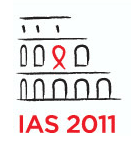 Gilead’s experimental once-daily integrase inhibitor (INI) elvitegravir works as well as Merck’s approved INI Isentress (raltegravir) in treatment-experienced patients, when both drugs are combined with a Norvir (ritonavir)–boosted protease inhibitor and a third antiretroviral (ARV), according to a presentation on Wednesday, July 20, at the 6th IAS Conference on HIV Pathogenesis, Treatment and Prevention in Rome.
Gilead’s experimental once-daily integrase inhibitor (INI) elvitegravir works as well as Merck’s approved INI Isentress (raltegravir) in treatment-experienced patients, when both drugs are combined with a Norvir (ritonavir)–boosted protease inhibitor and a third antiretroviral (ARV), according to a presentation on Wednesday, July 20, at the 6th IAS Conference on HIV Pathogenesis, Treatment and Prevention in Rome.
Forty-eight week data from the ongoing study, reported by Jean-Michel Molina, MD, of the Saint Louis Hospital in Paris and his colleagues, has allotted 702 participants to receive one of two doses of elvitegravir (either 150 milligrams [mg] or 85 mg once daily) or Isentress, plus a Norvir-boosted protease inhibitor to which the person’s HIV is fully sensitive, along with a third drug: either a nucleoside reverse transcriptase inhibitor (NRTI), Intelence (etravirine), Selzentry (maraviroc) or Fuzeon (enfuvirtide).
Volunteers were, on average, 44 years old upon entering the study. Roughly 18 percent are female, and 38 percent are people of color. About 4 percent are coinfected with hepatitis B virus, and roughly 15 percent are also living with chronic hepatitis C virus infection.
Average viral loads at the start of the study were around 25,000 copies, and 26 percent of participants in both groups had viral loads in excess of 100,000 copies. About 45 percent had CD4 counts below 200.
All participants had virus sensitive to the INIs used in the study. Nearly 70 percent had mutations conferring resistance to NRTIs, and more than 30 percent had a major resistance conferring resistance to available protease inhibitors. Roughly 62 percent had HIV resistance to two or more drug classes.
The most common protease inhibitor combined with either INI was Norvir-boosted Prezista (atazanavir), which was selected by 58 percent of study volunteers. The second and third most common were Kaletra and Norvir-boosted Reyataz (atazanavir).
Nearly 80 percent used an NRTI as their third agent, with nearly 60 percent of them selecting Viread (tenofovir).
After 48 weeks of treatment—the study’s primary milestone—59 percent of those in the elvitegravir groups, compared with 58 percent of those receiving Isentress, had viral loads below 50 copies, according to the strictest analysis that included all people who entered the study, regardless of whether or not they remained on their assigned treatment. In a less stringent analysis, which included only those who remained on treatment through 48 weeks, undetectable viral loads were documented in 75 percent and 73 percent, respectively.
Virologic failures were documented in 20 of those receiving elvitegravir compared with 22 of those receiving Isentress. Sixteen people in the Isentress group, compared with 11 in the elvitegravir groups, saw their viral loads rebound during the initial 48 weeks of the study, whereas eight people in the elvitegravir group, compared with five in the Isentress group, never got their viral loads to undetectable levels in the first place.
Two elvitegravir-treated participants and three Isentress-treated participants discontinued treatment because of adverse events.
CD4 counts increased by an average of 147 cells by week 48 in the elvitegravir groups, compared with an increase of 138 cells in the Isentress group.
The development of mutations conferring drug resistance was similar between the groups. New NRTI mutations developed in 12 percent of those in the elvitegravir group, compared with 13 percent of those treated with Isentress. New protease inhibitor–associated resistance mutations were documented in 7 percent and 4 percent, respectively. And INI mutations were documented in 27 percent and 21 percent, respectively, with some differences in the mutations that occurred in the groups.
Moderate-to-severe adverse events were documented in 19 percent of those in the elvitegravir groups, compared with 22 percent of those in the Isentress group. Only one adverse event was found to be more common in one group compared with the other: Diarrhea was documented in 12 percent of those in the elvitegravir groups, compared with 7 percent of those in the Isentress group.
There was one death among those taking elvitegravir, compared with eight deaths in the Isentress group. None of the deaths were believed to be associated with the study drugs used in the trial.
Moderate-to-severe laboratory abnormalities were uncommon and were comparable in all study groups.
In January, Gilead Sciences announced an amendment to this study, effectively extending it from the originally planned 48 weeks to 96 weeks in order to obtain longer-term safety and efficacy data. Additionally, Gilead continues to move ahead with the development of cobicistat, a novel agent that can be used as an alternative to low-dose Norvir, which is to be co-formulated with elvitegravir and manufacured separately for use in combination with other ARVs.






Comments
Comments